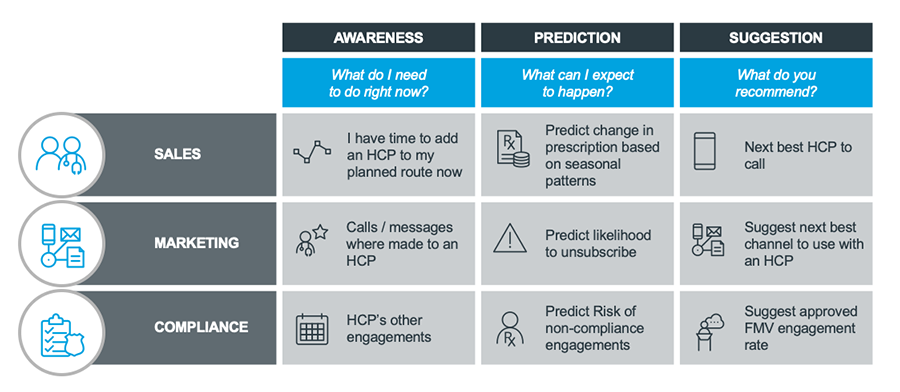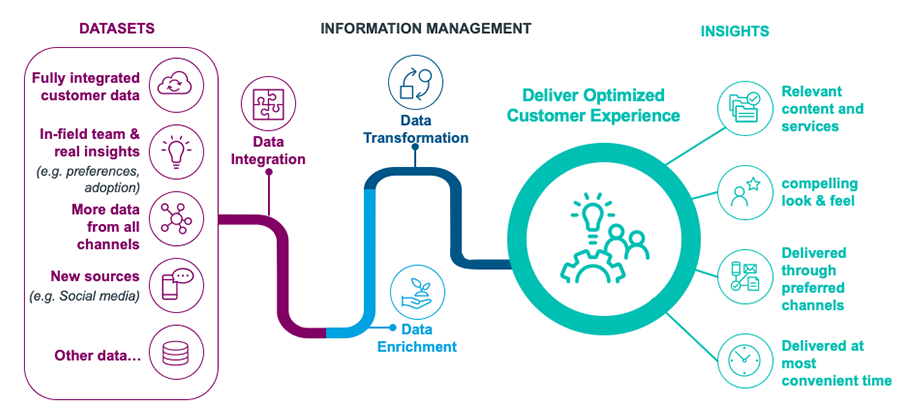











Previous blogs in the AI/ML in Life Sciences series: Beyond Classical Statistics, Using AI/ML to Generate Real World Evidence, and Leveraging AI/ML for Predictive Segmentation convey powerful examples of how analytic innovation is transforming the Life Sciences industry.
This blog will illustrate two of the top challenges hindering the adoption of AI/ML as part of daily decision making. They are 1) data complexity and 2) the ability to demonstrate return on investment. This blog will also discuss options and ideas that can help accelerate AI/ML adoption.
The Challenge of Data Complexity
The explosion of available data, together with price reductions in AI/ML solutions, have created new opportunities for companies to solve business challenges and realize novel insights. However, while these new opportunities allow companies to seize a competitive advantage and distinguish themselves in the market, they also come with some challenges. The first challenge is to prepare the data required and the complexities involved with integration.
Life sciences companies can now obtain access to more varied kinds of data to launch successful AI/ML programs. Examples of these various kinds of privacy protected data includes provincial insurance data, patient support program records, demographic, attitudinal or behavioral data, hospital records, claims data, sales and marketing activity, monitoring, social media, and customer-specific data. While these new data sources are very promising, they present integration, curation, and preparation challenges prior to being used in advanced analytics.
The Challenge of Demonstrating ROI and Showing Success
Over the past few years, life sciences companies working with these new data sources have been able to demonstrate the feasibility of AI/ML initiatives in areas such as:
- Natural Language Processing
- Image and video analysis for automated diagnosis
- Advanced clustering and segmentation for disease detection and patient diagnosing
- Deriving meaning and sentiment
- Virtual assistants (sometimes known as “chatbots”, “conversational AI entities”)
The proliferation of use cases and ready-to-use AI-powered tools have created increased pressure on companies to adopt AI and get access to as much available data as possible. The pace of innovation and pressure to adopt have led many organizations to ask the fundamental question, “Where do we start?”.
Where Should You Focus When Starting with AI/ML?
Consider focusing on high priority user needs that can demonstrate ROI. When determining if a company should start with a single AI/ML project or work to establish a sustained, comprehensive program, mapping the business requirements of each functional department along with their areas of greatest need is a good starting point. An example of this mapping process is illustrated in Figure 1. By prioritizing the needs of different stakeholders in an organization, it becomes possible to answer a series of questions:
- Can we deliver value with a single analytic project, or do we need to invest in new capabilities?
- Are the needs cross-departmental, or siloed by functional area?
- What kinds of data will be required to address the needs?
- Do we have the data scientists and platform required to perform the analysis?
The number of needs, their relative complexity, and the effort required to address them will determine the level of investment in an AI/ML program and its associated competencies.

Figure 1: Stakeholder mapping process
Early AI/ML adopters realized that data accessibility and data quality were the first requirements that had to be addressed. As a result, strategic industry advisors suggest companies start with data modernization roadmaps (programs), then scale AI as part of digital initiatives, and finally, integrate the data that matters most (enrich, measure data quality, and so on). Research shows that almost half of the leading companies that are exploring, experimenting, or actively pursuing AI are considering investing significantly in data management programs over the next three years.
Should You Consider DIY or Seek a Specialist?
Any life sciences company undertaking an AI/ML project, or program to answer the question of where they should start with this technology, would need to decide if they want to take a DIY approach or seek a partner specializing in this area. In a DIY approach, the company would need to build all the needed infrastructure, data engineering, data wrangling competencies, process or tools in-house. The company would also need to decide on the level of risk when rebuilding the data and AI/ML infrastructure each time they need to tackle a new and different use case or question.
Let’s take an example where a life sciences company needs to identify undiagnosed, untreated or even at-risk patients. This requires integrating millions or billions of deidentified prescriptions records, product definitions, physician and patient demographics data, attitudinal, behavioral and historical activity data points using unique identifiers, codes, dates and industry specific rules to bring reference and context. This integration process needs to be completed before starting the sophisticated data engineering steps for AI/ML purposes.
Companies deciding to undertake an AI/ML program, and invest in the required competencies to be successful, need to think seriously about the investment options:
- DIY solutions which are basically empty canvases powered by the necessary infrastructure or
- Turnkey platforms from companies like IQVIA with Life Sciences specific clouds.
DIY solutions may be a valid option for companies having the resources and ability to undertake the elements to prepare the data for AI/ML. These include matching and merging data, filling the gaps and cleansing, recruiting and training the data engineering skillset to execute all the data integration, imputation and normalization needed to create fit-for-purpose templates. This is required to bring the industry context and adhere to privacy legislation.
Companies choosing DIY solutions may end up spending 80% of their effort in preparing data and 20% extracting the AI/ML insights.
For others, a turnkey solution from a trusted partner provides a better option. Businesses that want to promptly unleash their next wave of business acceleration and disruption can leverage pre-populated, cross-referenced, privacy protected, and enriched data lakes.
Companies choosing turnkey solutions may end up spending just 20% of their effort in data preparation instead of 80%.
Life Sciences AI/ML Components
AI is among the most difficult of digital disciplines to master. Fortunately, companies can reap the benefits of these technologies from partners who have Life Sciences specific infrastructure and resources.
The rise of Life Sciences clouds presents a great opportunity for companies. This gives them access to large private healthcare data clouds, filled with relevant, high-quality data and tools and domain expertise in global healthcare analytics. These solutions promise to reduce the upfront investment. Companies can quickly achieve their AI/ML objectives by leveraging already linked and conformed physician, market, product, patient attributes, demographics, behavioral and attitudinal records. This allows for rapid development of new and unique models tailored to stakeholder’s specific questions and business needs.
The post-COVID landscape has created additional challenges for all of us in the Life Sciences industry including rapid shifts in the market and a need for novel methods to support the healthcare provider community. It is apparent that an omni-channel approach to the market is no longer a far-off goal, but instead a necessity to survive in the current environment. Investments in an AI/ML program need to explicitly consider how new and different sources of data (from different channels) will be made available to identify and predict opportunities and risks in this shifting marketplace with greater accuracy and shorter timeframes.
Post-COVID Landscape: Integrate Data to Identify and Predict Opportunities

Figure 2: Better customer experience through orchestrated, evidence-based, individualized, omnichannel engagement.
The Promise of a Life Science AI/ML Cloud
The promise of a Life Sciences AI/ML cloud to deliver valuable disruptive insights involves many components. It involves the collection, combination, protection and study of large, high-dimensional, sometimes unbalanced, structured or non-structured multi-source data sets. It leverages advanced analytics and transformative technologies. It utilizes life sciences expertise. This solid foundation will allow companies to accelerate AI/ML adoption, to make users familiar with AI applications, and empower those users to perceive the tools as decision making enhancers rather than substitutes.
Begin with an inventory of business needs. Evaluate available skills, tools, timelines, and budgets. Then decide if you want a large upfront investment (DIY data preparation) or choose an industry-specific already existing data lake. If you have questions or comments about this blog or would like to discuss how your business can benefit from AI/ML or Life Sciences clouds, contact Canadainfo@iqvia.com.
References:
1. Investing in AI: Moving Along the Digital Maturity Curve - Cognizant October 2019

